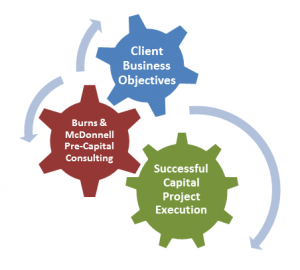 When significant operational changes require hefty capital investments, the stakes are high for an organization or company. Pre-capital planning is crucial to delivering a successful project, especially for companies that have multiple departments with diverse responsibilities or functions.
When significant operational changes require hefty capital investments, the stakes are high for an organization or company. Pre-capital planning is crucial to delivering a successful project, especially for companies that have multiple departments with diverse responsibilities or functions.
Pre-capital planning is focused on helping clients evaluate and systematically execute capital project plans. It’s fundamental to the strategic development that drives the ultimate success of the financial planning process.
By opening lines of communication across these multifunctional structures, businesses can tap into their full potential. In addition, a proactive partnership with a design-build firm positions the company to execute quickly — and get a timely return on high-rate-of-return projects in their portfolio.
Streamlining the communication and planning process can mean serious financial dividends for an organization. Pre-capital planning can make a difference to any department, whether it’s the commercial group planning to launch new products, the development team charged with packaging them or the finance department that wants proof of ROI.
Connecting a company’s multifunctional aspects with a design-build organization like ours creates a new capability for evaluating and delivering on opportunities. That’s because a new team dynamic naturally evolves when operational-oriented engineers from a design-build organization become a virtual part of the company’s team to evaluate, plan and create the potential for rapid execution.
For pre-capital planning, four key steps can help support business objectives faster and more holistically, giving the client more confidence the project is going to meet — and exceed — all expectations.
- Help drive clarity. Well-defined goals help organizations understand where and how to invest capital project dollars to produce optimal results: increased revenues and reduced costs.
- Encapsulate benefits. Faster alignment with people in key roles throughout the organization is critical, allowing clients to streamline goals and personnel before they start spending money — or even plan to spend that money.
- Understand the organization’s execution potentials. Demonstrating a thorough understanding of the need to rapidly execute the right projects leads to the best ROI for each type of project.
- Overall investment competence. By taking the time to properly vet a project, clients gain the added benefit of knowing their project portfolio is strong and financially sound.
Benefits come from high-level collaboration, within the client’s own company structure and with the pre-capital planning partner. This process is often a complement to master planning support, providing a strong understanding of a client’s multifunctional business structures.
If you’d like to learn more, feel free to send me an email or connect through LinkedIn. And if you’re headed to the Food Automation & Manufacturing Conference in Clearwater Beach, Fla., in a few weeks, I’ll be sharing case studies and more information in a presentation called “Before the RFP: Preparing for Capital Project Success” at 11: 25 a.m. on Tuesday, April 14.
Mal Warrick is a business development manager in Burns & McDonnell’s Food & Consumer Products division. Mal has more than 30 years of experience as a business development and operational leader with plant, supply chain, project and general management experience.
